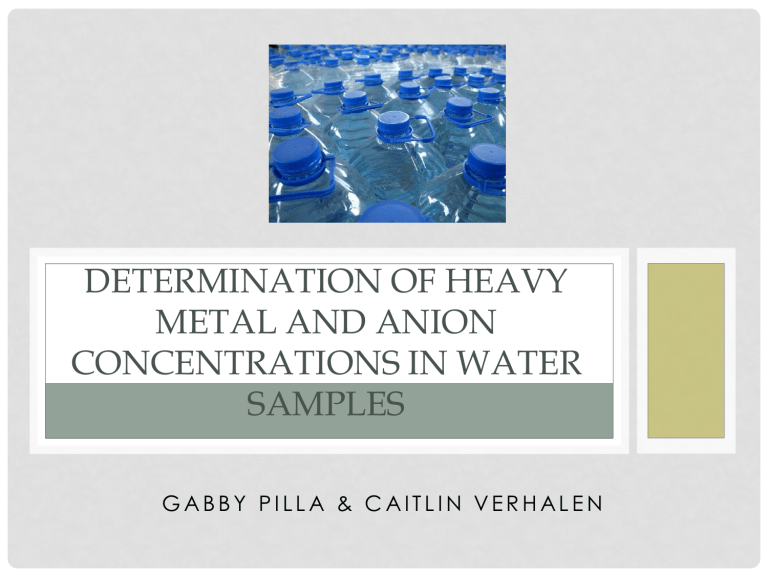Real World Project

DETERMINATION OF HEAVY
METAL AND ANION
CONCENTRATIONS IN WATER
SAMPLES
G A B B Y P I L L A & C A I T L I N V E R H A L E N
BACKGROUND
• Determination of contaminants in environmental, biological and food samples requires significant attention
• Some elements or their compounds have toxic or nutritional effects
• Regular monitoring of contaminant concentrations is required
• ICP and IC can be used for determination of various contaminants in water samples.
BACKGROUND
• Lead and copper enter water systems primarily through plumbing materials
• Can lead to symptoms ranging from stomach distress to brain damage
• An accumulation of cadmium in the body can affect several organ systems; nervous, gastrointestinal, reproductive and skeletal and biochemical activities.
• Health risks associated with arsenic include severe poisoning and carcinogenic, most importantly cancer of the respiratory and gastrointestinal tract.
• Fluoride can cause fluorosis or bone disease (Raja et al. 2013).
United State Environmental Protection Agency (EPA) National
Primary Drinking Water Regulations:
Contaminant
Aluminum
Arsenic
Cadmium
Lead
¹MCL
0.05-0.2 mg/L
0.010 mg/L
0.005 mg/L
0
Health Effects
No evidence suggests it is harmful; has been reported to cause dementia
Skin damage, problems with circulatory system, increase risk of getting cancer
Kidney damage
Kidney problems, high blood pressure, physical or mental developmental delays in children
Increase in blood cholesterol, decrease in blood sugar Antimony 0.006 mg/L
¹Maximum contaminant level
Anion
Fluoride
Chloride
¹MCL
2.0 mg/L
250 mg/L
Health Effects
Bone disease
Toxicity has not been observed but reported to produce hypertension
Nitrite 1 mg/L Causes blue baby syndrome and shortness of breath in infants <6 months
Bromide
Nitrate
No limits
10 mg/L
No adverse health effects
Causes blue baby syndrome and shortness of breath in infants <6 months
Phosphate 5 mg/L
Sulfate 250 mg/L
¹Maximum contaminant level
No adverse health effects
Occurs naturally, when very high it can cause diarrhea
OBJECTIVE
• Our purpose was to investigate whether purified or filtered water contains less toxic materials than tap water.
• Hypothesis:
• Store brand filters or water bottles will contain higher concentrations of contaminants compared to name brand filters or water bottles
SAMPLES & ANALYTES
Sample
Brita Filter
Store Filter
Leading Bottle
Store Bottle
Tap Water
ICP
Analyte
Aluminum
Arsenic
Cadmium
Lead
Antimony
IC
Analyte
Fluoride
Chloride
Nitrite
Bromide
Nitrate
Phosphate
Sulfate
METHOD- ICP
• 3 standards for the metals were prepared with dilution method:
• 10 ppm = 1 ml of 1000 ppm stock solution
100 ml DI water
• 10, 30, 50 ppm
• Standards and 5 water samples were analyzed
• For each contaminant two wavelengths were chosen to be analyzed
• Calibration curves were created for each contaminant for the two wavelengths separately and then averaged
METHOD- IC
• 7 anion standard ran after instrument equilibration
• Regenerant was prepared and refilled, allowing for production of a better spectrum
• 5 samples ran and compared to the 7 anion standard spectrum
DATA- ICP
Water Sample
Brita Filter
Store Filter
Leading Bottle
Store Bottle
Tap Water
Aluminum
(ppm)
1.967
2.466
1.966
1.966
2.000
Arsenic
(ppm)
0.676
0.497
0.482
0.471
0.462
Cadmium
(ppm)
-0.807
-0.811
-0.815
-0.823
-0.823
Lead
(ppm)
2.961
2.943
2.958
2.931
2.969
Antimony
(ppm)
12.937
5.911
4.647
4.257
4.118
DATA- IC
Sample
Fluoride
(ppm)
Chloride
(ppm)
Nitrite
(ppm)
Bromide
(ppm)
Nitrate
(ppm)
Phosphat e (ppm)
Sulfate
(ppm)
Standard
Brita
1
N/A
Store Brita
Leading bottle
0.040
N/A
Store Bottle
Tap Water
N/A
0.120
1
0.861
0.714
0.155
0.027
0.864
1
0.206
0.038
N/A
0.003
0.070
1
N/A
0.029
N/A
N/A
0.088
1
N/A
0.145
N/A
N/A
0.234
1
N/A
0.037
N/A
0.002
N/A
1
0.119
0.159
0.003
0.006
0.199
DISCUSSION- ICP
• Aluminum, Arsenic, Lead, and Antimony levels are all high for each water sample
• Store brand filter contained the highest aluminum levels
• Brita filtered water contained the highest arsenic levels
• Tap contained the highest lead levels although they were all very close in concentration
• Brita filtered water contained the highest antimony levels
• Cadmium levels were safe for each water sample
DISCUSSION- ICP
• Possible risks for those in who encounter these contaminants:
• Skin damage
• Circulatory system problems
• Increase risk of getting cancer
• Kidney problems
• High blood pressure
• High blood cholesterol
• Low blood sugar
DISCUSSION- IC
• No levels exceeded the acceptable maximum contaminant level. Therefore, no one is at risk for adverse health effects.
• The store bought filter contained all of the anions though they were at acceptable levels.
• The leading water bottle contained the least amount of anions.
• The water bottle samples contained the lowest concentration of anions compared to the Brita, store filter, and tap water.
CONCLUSION
• Hypothesis was rejected based on ICP data:
• Name brand filters and water bottles contained higher levels of contaminants versus store brand filters and water bottles
• Cheaper is better!
REFERENCES
• United State Environmental Protection Agency. National
Recommended Water Quality Criteria. http://water.epa.gov/scitech/swquidance/standards/current/index.
cfm (accessed May 10, 2013).
• Gholivand, M., Pourhossein, A., & Shahlaei, M. Simultaneous determination of copper and cadmium in environmental water and tea samples by adsorptive stripping voltammetry. 2011 Turkish Journal
Of Chemistry, 35(6), 839-846
• Raja, I. A., Khan, M. Y., Khan, N. A., Wani, M. R., & Bhat, A. A.
Assessment Of Some Metals In The Drinking Water Of Dal Lake
Kashmir. 2013. Nature & Science, 11(3), 63-64.










